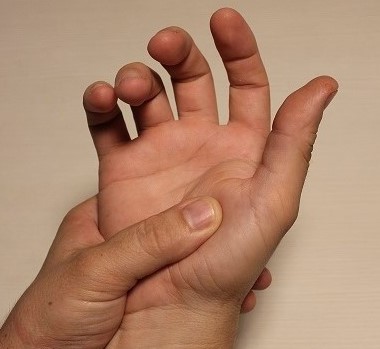Blog Post by Erika Lassig
Pins and needles in your hand waking you at night? Or does it come on when you’re driving the car? What about weakness in your hand or dropping objects? You may have Carpal Tunnel Syndrome (CTS). CTS affects about 2.5% of the population, which means it’s likely that you know someone who has these annoying tingles. And while lots of people have it and know what it is, not many people are aware that surgery is not the only treatment option! Let’s face it, no one wants to go under the knife if they don’t have to and the good news is that hand therapy can help! But let’s start at the beginning.
What is Carpal Tunnel Syndrome?
The main sensory nerve of the hand is called the median nerve. It supplies sensation to the thumb, index finger, middle finger and half of the ring finger. As the median nerve crosses the wrist, it must pass through a narrow tunnel formed by the small carpal bones at the bottom and a thick ligament called the transverse carpal ligament across the top. This space is called the Carpal Tunnel. Unfortunately for the median nerve, it has to share the space in the carpal tunnel with 9 tendons. And if anything happens in there to make the space a bit tight, whether that be fluid, inflammation or certain positions of the wrist, the median nerve becomes squashed. The symptoms produced by mechanical squashing of a nerve is called a nerve compression syndrome. There are several other nerve compression syndromes that occur in the upper limb, the nerves do have a long way to travel from the spinal cord down the arm and pass through various other pokey spaces along the way, but CTS is by far the most common.
Is it caused by the type of work I do?
To be honest, the jury is still out on whether particular types of work cause CTS, but if you already have some nerve compression present, then your work can most likely make it worse. There are lots of known causes of CTS. Genetic factors can contribute, with people of European descent more likely to experience CTS. In addition, diabetes, age and gender all play a role in causing the condition, with women more than 3 times likely than men to experience CTS. The majority of cases occur in people aged over 50 years. However, CTS can be made worse by poor posture, holding the wrist or hand in the same position for long periods of time, highly repetitive hand activity and vibration from hand tools and machinery such as a sander or jackhammer.
Embed from Getty Images
How do I get a diagnosis?
If you suspect you have CTS, I suggest first visiting your GP and requesting a test called a nerve conduction study. This test measures how fast the nerve transmits electrical impulses at different points along the arm and can identify how severe the damage to the nerve is and also in what place the compression is occurring (e.g. at the elbow or the wrist). If the nerve compression is severe, it is important to seek treatment ASAP to minimise the risk of permanent damage to the nerve. A nerve conduction study is not essential prior to commencing therapy and if you have to wait to have the test done then there is no problem starting therapy right away. An occupational therapist or physiotherapist who is a member of the Australian Hand Therapy Association (AHTA) will be able to do a thorough assessment to determine which treatments may be the most suitable for your needs.
What will therapy involve?
Most therapists will provide a splint which limits wrist movement (and in some cases finger movement) at particular times of day or night to reduce the compression of the nerve that occurs in certain positions. The type and wearing regime of the splint will depend largely on your symptoms, body shape and your lifestyle.
Several types of exercises can be provided to help the nerve to recover from any damage that may have occurred and prevent further injury from happening. These are usually low repetition movements that result in sliding the nerve and or tendons through the carpal tunnel.
Education of the client is a very important part of therapy because it teaches you what is happening in your own body, what to do to prevent compressing the nerve and how to manage your CTS into the future should symptoms return.
Is it better to get treatment straight away or can I wait?
The longer you have had CTS, the less likely that the nerve will recover completely. You are most likely to get a full recovery if you start therapy within the first six months of noticing the problem. So don’t delay, get back to what you love sooner and call The Hand Recovery Centre to book your appointment today!


